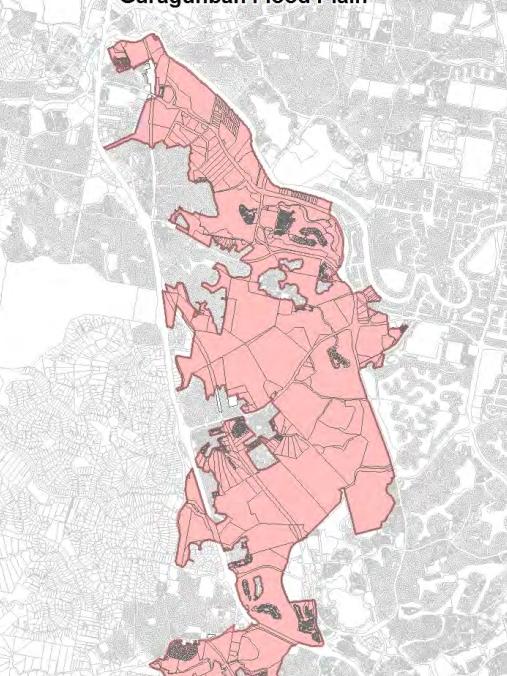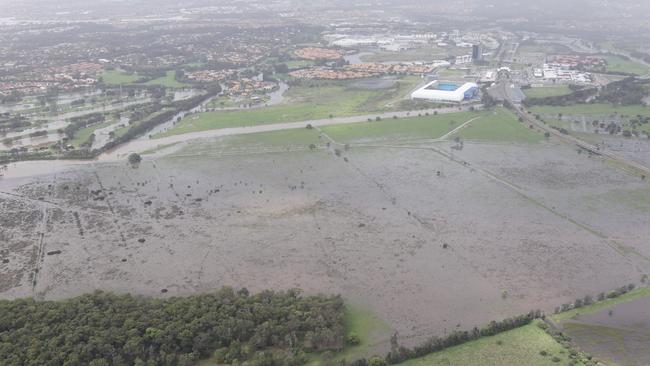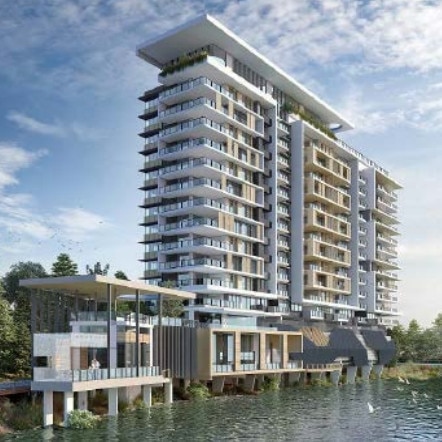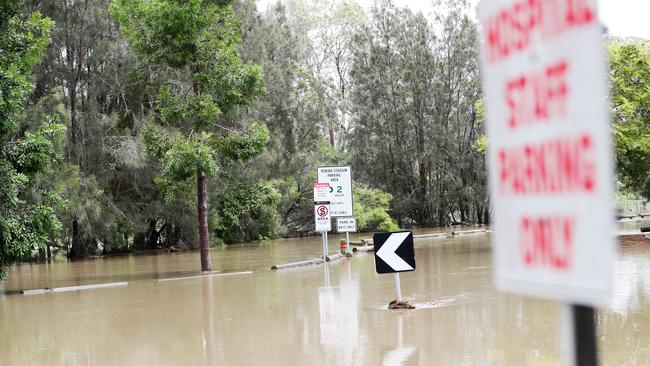Flood shock: where developers will be banned on the Gold Coast as tougher restrictions are introduced
Development is to be stopped on the Gold Coast’s biggest flood plain as council launches tough new planning restrictions.
Gold Coast
Don't miss out on the headlines from Gold Coast. Followed categories will be added to My News.
DEVELOPMENT is to be stopped on the Gold Coast’s biggest flood plain as council launches tough new planning restrictions.
At least four major developments are unlikely to proceed, adding to a protest by the property industry furious about a recent Robina decision which sets a precedent by requiring roads around a development to be flood free.

A special report in the Bulletin has detailed how developers believe the Robina retirement tower decision — subject to an appeal in the planning court — means “there’s hardly a development on the Gold Coast than can proceed when there’s a potential flood situation”.
The Bulletin can reveal a new report to the council’s planning committee has updated councillors on the Guragunbah flood plain which protects the properties from Southport to Burleigh on the coastal strip.
Since 1998 the council had attempted to protect the 1836ha area using various short-term planning options as it develops a “minimum flood free land policy”.
“While progressing this work, city officers became aware of nine development applications lodged in the flood plain which proposed to develop a total of 8782 dwellings comprising a mixture of medium density residential duplexes and apartment buildings,” the report said.

At least 3105 dwellings were to be on elevated engineered platforms extending out to the flood plain.
Council officers advised councillors that they were updating the flood overlay code and would brief them on October 29.
“It is anticipated that a draft flood overlay code and flood overlay map will be presented to council in February 2021,” the report said.
The current flood planning protection expired late last month and council officers were aware that at least four of the nine developments were still to be decided.
About 1542 properties on elevated platforms could be built.

Treasurer and State Planning Minister Cameron Dick has ticked off on council’s recommendation for another two-year temporary local planning instrument to stop development on the flood plain.
“I understand the proposed TPLI continues to reflect the complexities associated with development in the Guragunbah flood plain, particularly where it has the potential to expose people and property to adverse risks,” Mr Dick told council.
He said the council needed to fast-track changes to the City Plan so he could assess the work early next year.
Council planning committee chair Cameron Caldwell in an earlier response on the issue said
the council was currently reviewing the flood policy and code to ensure it remains up to date with best-practice management of development with respect to flood hazard.
“Public consultation will occur if there are any proposed changes to the City Plan’s Flood Code and this will occur before any changes take effect,” he said.
EARLIER:
DEVELOPERS say the council’s rules about building on flood plains are a bigger negative threat to the economy than COVID-19 and are crucial to how a bulging city will look in the future.
The decision by councillors to go against the recommendations of officers and reject a Robina tower retirement development has sent shockwaves and confusion through the property industry.

$50,000 FLOOD PLAN FOR RETIREMENT VILLAGE TOWER REJECTED
Experienced council insiders predict ratepayers will have to cough up more than $1 million in compensation and legal fees because a majority of councillors took safety precautions for residents to an extreme level.
A council source told The Bulletin: “The last time the council tried this (against a developer) on the flood plain we spent $1.8 million trying to defend it and lost.”
Flood plains are considered the final frontier for development on the Coast. Land is all but gone in the city’s fast-growing north and developers with deep pockets are squabbling over blocks on projected light rail routes.
MORE NEWS
Gold Coast development giant Sunland Group set to make changes to its Brisbane structure
Gold Coast man accused of distributing child abuse material arrested after USA tip-off
The Bulletin has obtained correspondence from developers to councillors asking for council to ease the confusion about development in areas like Robina near the flood plain.
Under SEQ Plan targets set by the State Government, the Coast is bracing itself for an extra 350,000 residents by 2041. But the Coast has limited greenfield sites.
Residents in the north are complaining about the lack of roads and schools, and coastal suburbs from Labrador to Palm Beach in City Plan consultation voted against proposed population increases. Developers are scratching around for limited suitable sites.

The council is moving to rule out development on the city’s main flood plain and the recent Robina decision, on a site nearby, sets tougher benchmarks around retirement village and nursing home projects.
A development industry source said council had previously used the one-in-one-100 flood event guidelines developed from the 1974 flood, but this had been updated to include sea-level rises and 2100 modelling.
However, the Robina development has set a precedent in that roads around a project had to be flood free.

“If that happens, as it stands, there’s hardly a development on the Gold Coast that can proceed when there’s a potential flood situation,” the development source said.
“Our road network has not been built to that (higher) flood standard. That’s when you can’t get anywhere. This (sort of flood level) is when Noah comes. In such events we will be leaving the building two by two with Noah loading his ship.”
Frustrated developers poised to spend tens of millions of dollars on projects have written to Mayor Tom Tate and councillors asking for clarification on the city’s flood policy.
“For the sake of the industry and the City – and indeed the State – can you or the council urgently advise what designated flood level is council using to determine the applicable flood level,” a developer wrote.

A councillor responding to a developer admitted the Robina decision was “regrettable”.
Only Deputy Mayor Donna Gates and Councillor Peter Young, two of the city’s most experienced representatives on planning, voted against stopping the project.
The Bulletin asked the council if its planning officers were still using the 1974 flood as a guide, or working off a perceived flood level for the year 2100, or another created by the State and Commonwealth that takes into account global warming.
Council was also asked, if the 2100 level was the benchmark, how did this affect roads. The Bulletin asked whether a list of flood-affected roads had been created so developments eyeing off potential sites could view them.

In a response, council planning chair Cameron Caldwell said: “The City will continue to assess development applications with regard to the City Plan’s Flood Overlay Code, as currently in effect. The City Plan’s Flood code requires the floor level of residential developments to be constructed 300mm above current designated flood level. The Flood Code also has requirements for flood-free access, which depend on site specific circumstances.
“The City is currently reviewing the flood policy and code to ensure that it remains up to date with best-practice management of development with respect to flood hazard. Public consultation will occur if there are any proposed changes to the City Plan’s Flood Code and this will occur before any changes take effect.”


